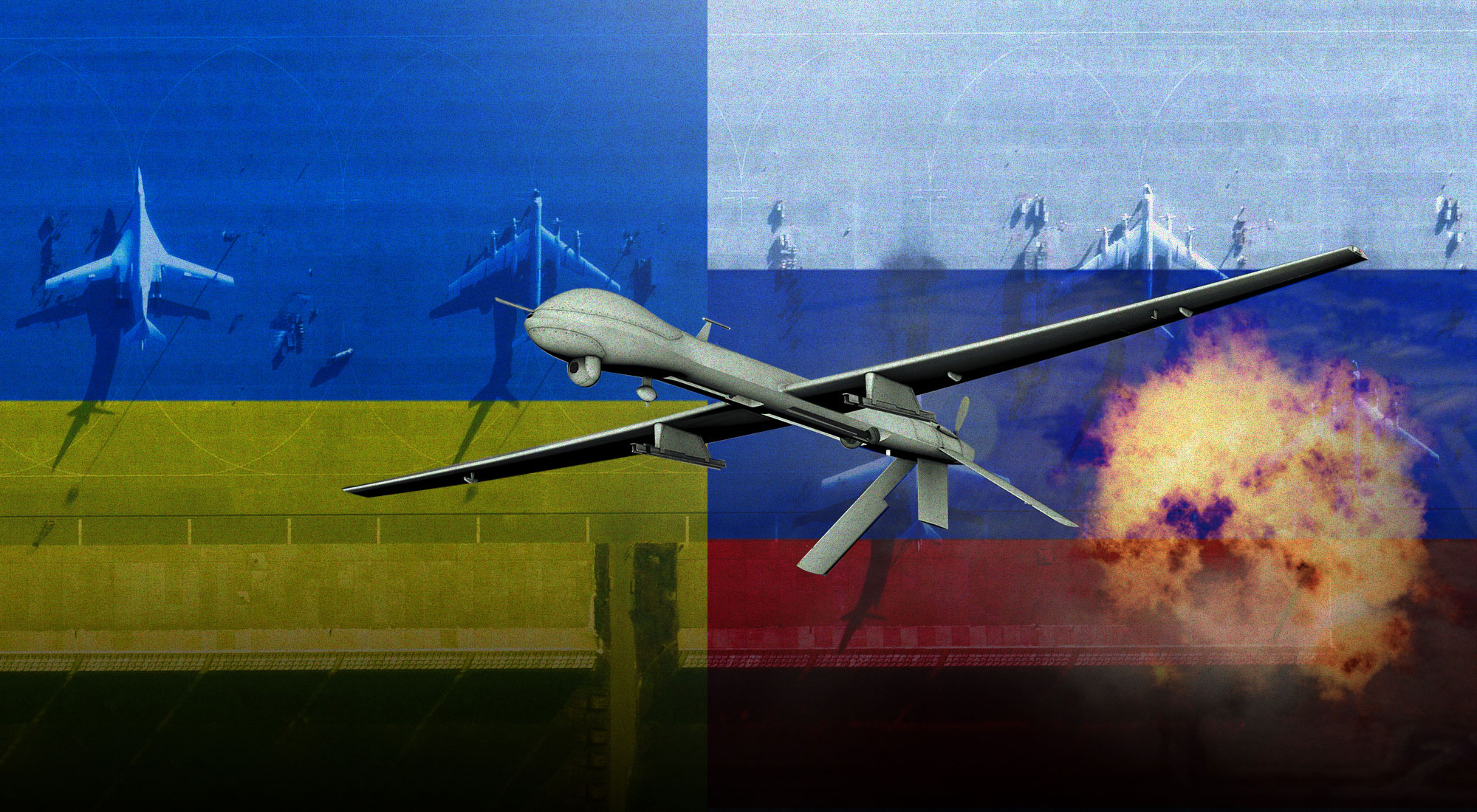In the most recent escalation of hostilities between Israel and Iran, Iranian military installations located in Isfahan were reportedly targeted in early morning airstrikes on 19 April. ABC News, citing a senior U.S. official,[1] suggests that the Israeli army likely utilized Jericho 2 or Jericho 3 missiles in these attacks. Additionally, strikes were carried out on a radar facility in the Suwayda Governorate in southern Syria. There are also reports of further strikes on similar sites within Iraq.
While it’s anticipated that Iran will respond to these attacks, the magnitude of their retaliation hinges on the extent of Israeli military actions, which remains uncertain. Iranian officials’ attempts to minimize the scale and impact of the Israeli attack suggest that Tehran may be leaning towards a restrained response to prevent further escalation in the region. However, this approach is dependent on Israel abstaining from further attacks.
Conversely, although Israel might hope that Iran will choose to use its proxies to respond in a way that de-escalates the situation, there’s no guarantee of this outcome. The direct retaliation by Iran against Israel on 13 April, originating from its territory instead of via intermediaries, was unexpected and raised eyebrows among experts. This move constituted a notable deviation from the established rules of engagement in the ongoing “shadow war” between the two regional powerhouses in recent years. The attacks on 19 and 13 April, along with the Israeli strike on the Iranian consulate in Syria earlier in the month, indicate more than just a display of each side’s ability to bypass the rules of engagement that have characterized their “shadow war” for the past two decades. They represent a clear break from that stage.
Israel and Iran now appear to be entering a phase of “escalation,” the outcome of which is highly uncertain. It’s unclear whether the two sides will revert to the status quo before the consulate attack. The idea of deterrence between the two parties has been seriously undermined by this exchange of strikes, giving rise to considerable room for miscalculation and a risk of escalation. This extends beyond the threat of an outright war between Israel and Iran or the escalation of hostilities in the region. It also encompasses the likelihood of Iran intensifying efforts to enhance the military capabilities of its proxies. Moreover, the erosion of the deterrence concept, and the lack of favorable incentives to halt its nuclear program, may drive Iran to expedite its entry into the “nuclear club.”
Concept (meaning) and forms of deterrence
The process of preventing an individual or entity, usually a nation-state, from acting in an undesired way — most notably armed aggression — is known as deterrence.[2] “Direct deterrence” and “extended deterrence” are two main categories into which deterrence is divided in classical literature. Direct deterrence involves a state’s endeavors to prevent attacks within its own territory, as exemplified by Israel’s efforts within its borders. Extended deterrence, on the other hand, encompasses measures to deter attacks on third parties, such as allies or partners.[3]
There are two fundamental approaches to deterrence: denial and punishment. Denial strategies aim to discourage action so that the potential aggressor’s confidence in achieving its objectives is undermined by making it impossible or improbable for them to succeed. This might involve deploying sufficient local military forces to repel a potential invasion, for instance. On the other hand, punishment-based deterrence entails raising the perceived cost for the aggressor by threatening dire consequences in response to an attack, such as harsh economic sanctions or nuclear escalation.[4]
Eroding deterrence between Israel and Hezbollah
It appears that both types of deterrence, extended and direct, between Israel and Iran have significantly weakened during the current crisis. Neither party seems to perceive any compelling reason to halt the attacks or escalate their costs. The United States, alongside the United Kingdom, appeared to be pursuing the implementation of “extended deterrence” by deploying military assets off the coasts of Israel and Lebanon since last October. This move aimed to discourage Iran and its allies from opening a broader front with Israel until Israel ceased its operations in the Gaza Strip. Initially, it appeared that these American actions succeeded in deterring Hezbollah, Iran’s primary proxy in the region, from engaging extensively in confrontations with Israel. Attacks and counterattacks between Israel and Hezbollah continued within the usual rules of engagement between the two sides, at least until last March.
However, this “extended deterrence” has eroded over time for at least two reasons:
Firstly, despite extensive support in logistics, military, and intelligence, Israel has struggled to achieve its stated objectives of neutralizing Hamas and freeing its abducted citizens from the Gaza Strip. This apparent failure may embolden adversaries to further undermine Israel and escalate attacks against it.
Secondly, while Israel’s key allies demonstrated readiness to defend it against Iranian missile and drone attacks on 13 April, they appear less inclined to actively deter Israel’s adversaries by engaging in strikes against Iran or its proxies. This was made evident by Washington’s explicit statement regarding its stance on such actions.
The erosion of deterrence has heightened the likelihood of a full-scale conflict erupting between Israel and Hezbollah in the northern region, bringing the prospect closer to realization than ever before. Notably, Hezbollah has significantly escalated its attacks on northern Israel and Israeli settlements in the Golan Heights since the beginning of March, firing numerous Katyusha rockets on multiple occasions. Even the Israeli Minister of National Security, Itamar Ben Gvir, known for his far-right stance, directed a message to Defense Minister Yoav Gallant in response to Hezbollah’s missile strikes, stating: “The military is your responsibility. What are you waiting for? We have to start responding, attacking – war, now.”[5]
Following the Iranian attack on Israel on 13 April, tensions escalated further. Israeli strikes in Lebanon’s Bekaa Valley and the assassination of a Hezbollah commander on 16 April contributed to this escalation. Simultaneously, Hezbollah intensified its attacks, employing more sophisticated drones to target Israeli Iron Dome batteries. According to reports from the Times of Israel newspaper, on 17 April, Hezbollah launched a drone strike on a community center in the Bedouin village of Aramsha in northern Israel, resulting in the injury of at least 18 Israeli soldiers.
This attack indicates the willingness of the party involved to carry out strikes resulting in significant losses, aimed at preserving deterrence against Israel.
The importance of this deterrence has been underscored by the Iranian missile attack on Israel, as Hezbollah seeks to forestall Israeli strikes against the party and its sites, which are among Israel’s potential responses to Iran. However, the Israeli response to Hezbollah’s attacks suggests that retaliatory strikes are unlikely to dissuade them. As a result, cross-border exchanges are likely to persist, bringing Israel and Hezbollah closer to a wider conflict, particularly if either side misjudges the scale or impact of any attack.
Eroding deterrence between Iran and Israel
Israeli calculations seem to have taken into account the weakening of Israeli deterrence against Hezbollah, prompting a shift toward a more direct confrontation with Iran. Decision-makers in Israel seemingly concluded that the “shadow war” against Iranian elements abroad and covert strikes within Iran were no longer sufficient to directly deter Tehran. On 1 April, Israel initiated a direct strike, targeting the Tehran consulate in Damascus and eliminating military targets, including senior Iranian Revolutionary Guard officers. This marked the beginning of a new phase of direct confrontations with Iran, as evidenced by the three rounds of exchanges thus far in April. With neither party possessing the strength, leverage, or positive incentives to halt the escalation, there is little to prevent or deter them from continuing to launch strikes and counterstrikes.
Iran’s statements suggest a determination to respond to Israeli actions. Like Israel, Iran aims to assert that it has regained deterrence and to convey a clear message that attacking its territory would incur significant costs, making it an undesirable option for Israel. Although neither party desires to spark a wider regional conflict, the risk of inadvertently slipping into such a scenario grows as their confrontations turn from a “proxy war” into a “direct conflict.”
The Iranian attack using drones and missiles had a significant impact on undermining the concept of “deterrence” among Israeli military decision-makers. Despite the assistance of several of Israel’s allies in repelling most of the attacks, some Iranian missiles managed to hit military targets within Israel itself. According to Israeli military strategy, deterrence must involve striking the opponent and preventing or discouraging them from attacking Israeli territory simultaneously. The Israeli response on 19 April, targeting Isfahan, does not appear to have been adequate in this regard. However, this does not diminish Tehran’s continued capability and now, seemingly, its inclination to strike Israel. Therefore, it is unlikely that this attack will mark the end of a series of escalations by Israel. Rather, Israel likely maintains a list of targets to strike inside Iran, including infrastructure for manufacturing and managing missiles and drones, as well as Iranian nuclear facilities.
Where do Iran’s nuclear program, proxy actors fit into the game of deterrence?
The erosion of deterrence between Israel and Iran is likely to influence their perspectives on two crucial issues: the nuclear file and the handling of Iranian proxy actors in the region.
The first issue: In light of Tehran’s decision to directly attack Israel for the first time, Israel is likely to intensify its focus on the Iranian nuclear program. This attack demonstrated Tehran’s willingness to risk escalating tensions with Israel and showcased its increased capacity to absorb risks, potentially extending to its nuclear program. As a result, Israel may feel a greater imperative to disrupt Iran’s nuclear activities. Additionally, Iran’s failure to inflict significant harm on Israel using conventional weapons like drones and missiles may lead Israeli leaders to reassess the magnitude of the Iranian missile threat. If Israeli leaders become more confident in their ability to withstand a conventional military response from Iran, they may be more likely to consider direct military action against Iran’s nuclear facilities, drones, and missiles, even after the current crisis has been resolved.
The limited impact of the Iranian strike on Israel on 13 April suggests that Tehran’s deterrence against Israeli attacks is also limited. Consequently, Tehran may recognize that Israeli leaders could be more inclined to authorize future military strikes on Iranian missile, drone, and nuclear facilities. This realization could prompt Tehran to seek to bolster its deterrent capabilities, potentially including the pursuit of nuclear weapons. However, it’s worth noting that possessing nuclear weapons offers only limited deterrence against conventional military action. Furthermore, the Israeli strike on Iranian territory on 19 April may prompt Tehran to consider retaliatory measures. If Iran aims to escalate tensions with Israel without triggering a cycle of reciprocal strikes or outright war, it may opt to escalate its nuclear program, such as by ramping up uranium enrichment activities.
The second issue: The ongoing cycle of mutual escalation underscores Iran’s commitment to supporting its allied militias in Iraq, Syria, and other regions. By bolstering these militias, Iran aims to reduce the need for Iranian drones to travel long distances to reach Israeli territory, thereby minimizing their vulnerability to interception by Israeli aircraft and defense systems. Drones launched by Iranian paramilitaries in Iraq or Lebanon would have shorter distances to cover, increasing the likelihood of reaching Israel and putting strain on Israel’s multi-layered air defense systems. Additionally, supplying more drones, ballistic missiles, and cruise missiles to these proxies could achieve similar objectives. However, these transfers would also expose Iran’s arsenal to the heightened risk of Israeli preemptive airstrikes. Israel has demonstrated a strong willingness to conduct frequent airstrikes targeting the supply chain of Iranian missiles and drones to its proxies in Syria and Lebanon.
This suggests that we are on the brink of new rules of engagement between Israel and Iran, where neither side will hold clear dominance or be able to establish effective deterrence independently. Instead, the intervention of a major international power, particularly the United States, may be necessary to control the situation and dissuade both parties from engaging in reckless attacks with potentially catastrophic consequences.
[1] “Israel Responds to the Iranian Attack,” Rane Worldview, April 19, 2024, https://worldview.stratfor.com/article/israel-responds-iranian-attack (Accessed: 20 April 19, 2024)
[2] Michael J. Mazarr, “Understanding Deterrence,” RAND, April 19, 2018, https://www.rand.org/content/dam/rand/pubs/perspectives/PE200/PE295/RAND_PE295.pdf (Accessed: 19, 20 April, 2024)
[3] Ibid, p.2.
[4] Ibid, p.4.
[5] “Counting Hezbollah attacks… Ben Ghafir to the Minister of Defense: What are you waiting for?” Al Hurra, March 12, 2024, https://www.alhurra.com/israel/2024/03/12/%D9%87% D8%AC%D9%85%D8%A7%D8%AA-%D8%AD%D8%B2%D8%A8-%D8%A7%D9%84%D9%84%D9%87-%D8%A8 %D9%86-%D8%BA%D9%81%D9%8A%D8%B1-%D9%84%D9%88%D8%B2%D9%8A%D8%B1-%D8%A7%D9% 84%D8%AF%D9%81%D8%A7%D8%B9-%D8%AA%D9%86%D8%AA%D8%B8%D8%B1%D8%9F. (Accessed: 19 April, 2024)









